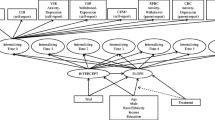Abstract
Minimizing participant attrition is vital to the success of longitudinal research. The Developmental Trends Study (DTS), a longitudinal study of the development of disruptive behavior disorders, has achieved a low attrition rate throughout the study. The development of early retention strategies, managing contact and scheduling history through the use of electronic databases, interviewer persistence, and the emergence of new electronic search methods have contributed to the success of our study. A literature review of retention methodology and practical solutions to maintain participant cooperation is described. A case study of the DTS is presented to inform researchers in longitudinal research on new methods used to maintain high retention rates.
Similar content being viewed by others
REFERENCES
Badawi, M. A., Eaton, W.W., Myllyluoma, J., Weimer, L. G., & Gallo, J. (1999). Psychopathology and attrition in the Baltimore ECA 15-Year follow-up 1981–1996. Social Psychiatry and Psychiatric Epidemiology; 34, 91–98.
Capaldi, D. & Patterson, R. (1987). An approach to the problem of recruitment and retention rates for longitudinal research. Behavioral Assessment; 9, 169–177.
Coen, A. S., Patrick, D. C., & Shern, D. L. (1996). Minimizing attrition in longitudinal studies of special populations: An integrated management approach. Education and Program Planning; 19, 309–319.
Eckland, B. K. (1968). Retrieving mobile cases in longitudinal surveys. Public Opinion Quarterly; 32, 51–64.
Elliott, K. (2001). Reverse search inside out, Part 1: Why and how to search backwards. [On-line]. Available: Reverse search.com.
Farrington, D.P., Gallagher, B., Morley, L., St. Ledger, R. J., & West, D. J. (1990). Minimizing attrition in longitudinal research: Methods of tracing and securing cooperation in a 24-year follow-up study. Data Quality on Longitudinal research (pp. 122–147). New York, NY,: Cambridge University Press.
Flick, S. N. (1988). Managing attrition in clinical research. Clinical Psychology Review; 8, 499–515.
Green, S. M., Navratil, J. L., Loeber, R, & Lahey, B. B. (1994). Potential dropouts in a longitudinal study: prevalence, stability, and associated characteristics. Journal of Child and Family Studies; 3, 69–87.
Hollingshead, A. B. (1975). Four factor index of social status. New Haven, CT. Yale University.
Navratil, J. L., Green, S. M., Loeber, R., & Lahey, B. B. (1994). Minimizing subject loss in a longitudinal study of deviant behavior. Journal of Child and Family Studies; 3, 89–106.
Prinz, R. J., Smith, E. P., Dumas, J. E., Laughlin, J. E., White, D.W., & Barron, R. (2001). Recruitment and retention of participants in prevention trials involving family-based interventions. American Journal of Preventative Medicine; 20, 31–37.
Ribisl, K. M., Walton, M. A., Mowbray, C. T., Luke, D. A., Davidson II, W. S., Bootsmiller, B. J. (1996). Minimizing participant attrition in panel studies through the use of effective retention and tracking strategies: Review and recommendations. Evaluation and Program Planning; 19, 1–25.
Stouthamer-Loeber, M., van Kammen, W., & Loeber, R. (1992). The nuts and bolts of implementing large-scale longitudinal studies. Violence and Victims; 7(1), 63–78.
Sullivan, C. M., Rumptz, M. H., Campbell, R., Eby, K. K., Davidson II, W. S. (1996). Retaining participants in longitudinal community research: A comprehensive protocol. Journal of Applied behavioral Science; 32, 262–276.
Ullman, J. B. & Newcomb, M. D. (1998). Eager, reluctant, and nonresponders to a mailed longitudinal survey: Attitudinal and substance use characteristics differentiate respondents. Journal of Applied Social Psychology; 28, 357–375.
Author information
Authors and Affiliations
Corresponding author
Rights and permissions
About this article
Cite this article
Cotter, R.B., Burke, J.D., Loeber, R. et al. Innovative Retention Methods in Longitudinal Research: A Case Study of the Developmental Trends Study. Journal of Child and Family Studies 11, 485–498 (2002). https://doi.org/10.1023/A:1020939626243
Issue Date:
DOI: https://doi.org/10.1023/A:1020939626243




